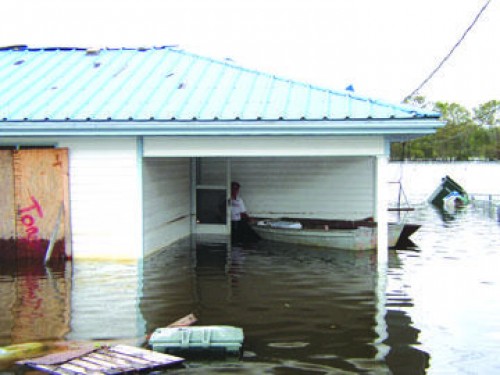Thibodaux Regional Medical Center’s North Hospital project complete
October 20, 2006A year later, is the region ready?
Nearly one year ago, Hurricane Rita brushed the Tri-parishes’ shore causing widespread flooding. The Tri-Parish Times asked officials to revisit where we were and what we’ve since changed if the Gulf Coast had to face another storm after the storm.
Terrebonne taking steps to protect parish from future flooding, storms
When threat of bad weather encroached on the lives of Tri-Parish residents, it was assumed Rita would be like any other hurricane. Managable. Many stayed and endured the storm.
But what Rita left behind, like Katrina, was the astonishing realization of the true destruction that a storm can produce with the right conditions. Yet the latest movement of positive effects leaves a feeling of hope and possible renewal.
Terrebonne Parish faced a harsh reality and now officials, one year later, vow to prepare and be prepared in time for the next storm.
After Katrina n Rita
With all eyes on New Orleans, when Rita made her way into the Gulf and hit further west, few realized the damage that ensued from both hurricanes on Terrebonne Parish.
“Katrina, we had some wind damage and evacuees”, remembers Houma Police Chief Patrick Boudreaux. “We had begged the state for room in our shelters because we didn’t know exactly where Rita was coming at the time.”
Terrebonne began preparing for the worst but the majority of the damage was left to the southern regions of the parish. Rita’s storm surge, even 200 miles offshore, left communities with nothing but cement foundations. Houma did see some surge damage from overflowing canals. Both regions were spared from unforgiving winds.
Over 10,000 homes and businesses were flooded.
“It was a shock to see how far away we were from the eye of storm, it was amazing to see how fast the water came up,” said Parish President Don Schwab, referring to the flooding of the five fingers of Terrebonne. “That was the initial shock.”
“Rita didn’t really present much of a burden to us that we weren’t already doing because of Katrina,” said Boudreaux, the initial issues were finding safe haven for those who lost homes.
Terrebonne residents somehow found a way to do both react to Katrina and face their own disaster.
Rebuilding After The Storm
No one could predict the aftermath of the surge. People returned to find their homes and communities submerged. Levees supposed to protect, and canals predicted to channel had failed.
In a situation many would have left, Terrebonne residents stayed. Cleanup was initiated but not with the help of federal crews.
“People out here have been through so many [hurricanes] over the years that they just went to work cleaning their houses and doing what they had to do.
They didn’t wait for the federal government. Unfortunately, we weren’t going to get help as fast because we didn’t suffer as greatly as some of our neighbors, “said Schwab.
The results are looking better and better for Terrebonne. Sales tax income is soaring and business is booming at the rate or better than before Rita, says the Terrebonne Tax Department. Whether people are traveling to the parish to do so, money is being spent and revenues are up.
“The first couple of months after Rita we very fortunate to have some supermarkets in town to remain open through the efforts of our utilities department and Tom Bourg and Entergy and Sleek. We were up 50-some percent in November and December. Now we are still up 20 percent on average a month over what we have done before,” said Schwab.
The Terrebonne Parish Council has seen benefit from those increase and will have $8 to $9 million extra to spend in the 2007 yearly budget to continue recovery and to install better protection.
Students and teachers headed back in school in the first week of September, unlike some of their peers in surrounding parishes, without delay.
According to Chief Boudreaux and Sheriff Jerry Larpenter of crime is lower than one year ago. “We have had more calls for service, but generally we have not seen an increase in overall crime rates,” says Larpenter. Terrebonne has not encountered the violence that ensued after displaced Katrina victims transplanted to Houston, Baton Rouge and all along the Gulf Coast.
Schwab attributes previous and present absence of crime to the efforts of the local authorities.
“Chief Boudreaux and Sheriff Larpenter’s department did a great job of surveillance and going through neighborhoods. We’ve been very fortunate compared to what surrounding parishes are facing,” he said.
Calls for service have increased for the Houma Police as well as traffic volume. A slight population increase has caused a need for additional officers, with budgeting coming up, Boudreaux will push for that assistance.
Preparing for the Future
Effects from Rita may not be fully understood for some time, officials agree. As Terrebonne residents continue the recovery along with Katrina victims, many of the trends seen now may be obsolete down the road.
What parish officials are doing now is monitoring and preparing for the future.
Although victims have moved into the parish, as rebuilding in New Orleans and surrounding parish continue, an additional shift in population could affect the positive trends seen in Terrebonne.
“What we are doing is monitoring school populations, traffic volumes, calls to service and charting those to see if we can track population trends. Not only will that help us, it will help people in the nation to know what to expect after a natural disaster,” said Boudreaux.
He has also implemented a strategic statewide plan for better utilization of police services if and when another storm or state-emergency should happen.
Communication was lacking during Katrina and Rita and untapped resources in other areas of the state could have helped in the situation S. Louisiana faced.
“If there is an emergency that would exceed our resources that we have on a law enforcement basis we could call on our task force team together and police officers and equipment from around the state would be available,” said Boudreaux. “Certified officers who have been trained in national incident management would proved better coordinated service.”
All parishes have joined the statewide network.
The next step for the parish is to focus on hurricane protection and coastal preservation. The proposed one-cent tax in Terrebonne Parish would go toward rebuilding levees, locks and put in place proper precautions to protect all that is progressing.
“The one-cent tax is for the survival of Terrebonne Parish. Morganza-to-the-Gulf is not going to happen anytime soon so when I put together for the levee committee to meet and come up with some kind of plan we came up with. Nobody likes taxes but we have to protect ourselves,” said Schwab.
What the levee committee surveyed is that if interim levee of South Terrebonne would have been 10 feet, perhaps not a home would have been flooded.
“This money will go to construction and maintenance of levees only, period. That’s it, no studies, just construction and maintenance,” the parish president said.
The greatest impact Rita and Katrina have made is the awareness of the previous situation, and what needs to be done now to protect for a future storm. As long as there is oil to be supplied and fish to be caught and supplied to the nation, it becomes imperative for South Louisiana life and Terrebonne Parish to continue.
“The storms left such an impact on us. Now we know, what can happen if a Category 4 or 5 storm can do if it directly hits us. We saw it on either side of the parish and we were spared to the point where it wasn’t as catastrophic. All these years, people didn’t realize what could happen. What people realize now is the impact of the water, the surge can do so much damage and we have to protect ourselves,” said Schwab.
Andrea Carlson can be reached at (985) 876-3008 or andrea@tri-parishtimes.com.












